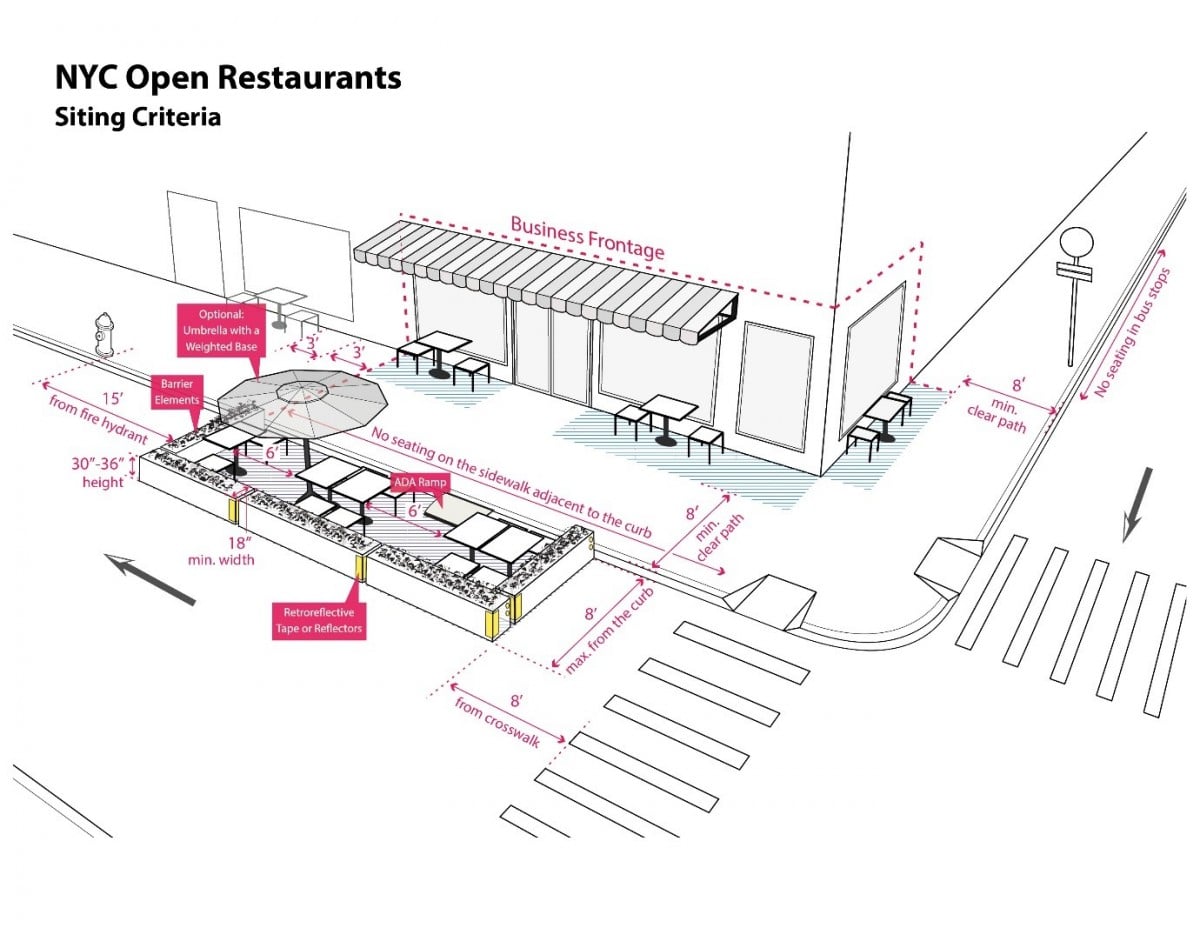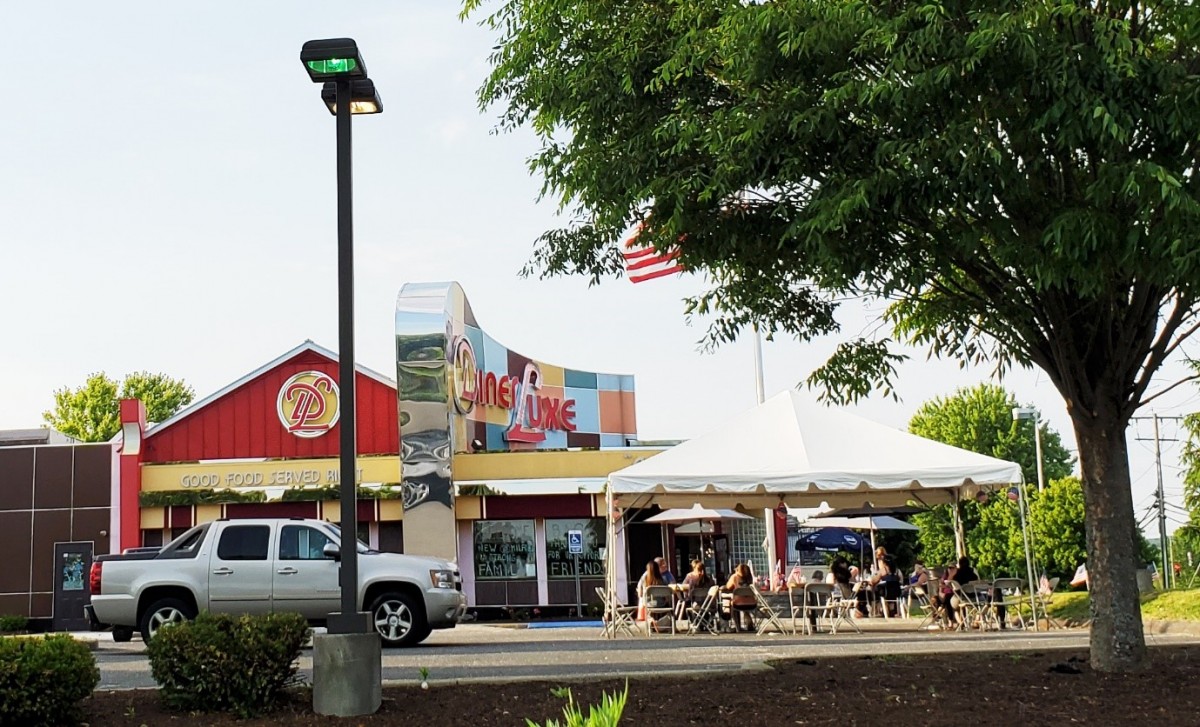Originally published on CEBM.net on 24 August 2020
Anne Marie Sowder
Assistant Professor, City University of New York, New York City College of Technology; MSc Sustainable Urban Development, University of Oxford
Correspondence to [email protected]
VERDICT
The expanded use of streets, sidewalks, and parking lots to include gathering and dining due to COVID-19-related physical distancing measures has the potential to improve the urban environment, and should be adopted permanently where practical.
BACKGROUND
Social distancing due to the COVID-19 pandemic is activating urban spaces in new ways. Both private and public outdoor spaces have been drawn into service as the amount of room required for in-person interaction has driven dining onto sidewalks, streets, and parking areas. Combining public health concerns with economic downturns, a return to normal capacity functions is not expected in the United States until 2021. A plan for improving the urban environment in lieu of simply returning to normal at that time would include some of the changes that have been adopted to combat disease transmission.

CURRENT EVIDENCE
States allowing indoor activities in the United States have experienced surges in cases of COVID-19 throughout the summer of 2020, and some have slowed or reversed reopening plans. Indoor restaurant dining is particularly problematic. Universal masking is understood to reduce the opportunity for transmission, but masks are removed for eating and drinking. California, Florida, Illinois, New Jersey, New York, and Pennsylvania currently restrict indoor dining in some or all areas to combat transmission. In mid-March 2020, New York State mandated that indoor dining capacity be reduced by 50 percent, moving to a full ban on indoor dining within days. The state’s phased reopening guidelines currently mandate that, where allowed, indoor sit-down dining resumes at only half-capacity, with six feet of distance between each table or physical barriers at least five feet in height. Outdoor dining, where allowed, must also observe the six feet spacing rules.
Declines in dining out and changing rules for operation have impacted restaurants, where expenses are relatively fixed and small seating areas are hard hit by further restrictions in capacity. Evidence of the stress comes from finding of a March survey by the National Restaurant Association that over half of U.S. restaurant operators had switched to fully off-site services including takeout and delivery meals, 70 percent had had to reduce staffing, and half expected further layoffs in April. Additionally, the June NYC Hospitality Alliance survey results indicated that 80 percent of restaurant, bar, and club respondents did not pay full rent in June, and 36 percent paid no rent at all.
Expanding space for outdoor service has allowed for a revival of onsite food service that meets guidelines for six feet of social distance between patrons. In New York City, where the City Council drove efforts to expand outdoor dining offerings, a streamlined application process exists for restaurants seeking sidewalk or curbside space, and the city reports over 9,400 sidewalk or curbside programme participants as of August 2020, about a third of pre-pandemic total restaurants. No additional permissions are required for restaurants to operate in privately owned spaces or parking lots. Conceived of in May and rolled out in June 2020, expanded outdoor dining has not been linked to a spike in reported positive test case results. Popularity of the outdoor dining programme has led to a City Council proposal to expand the outdoor allowances permanently.
If made permanent, these changes would dramatically alter the streetscape where adopted. An extensive 2007 survey of the public realm in New York City emphasized its relative dearth of outdoor and café seating: at the time of survey, New York City had 15 café seats per 1,000 yards; London, Regent Street had 137 café seats per 1,000 yards; and Copenhagen, Strøget had 444 café seats per 1,000 yards. Former NYC Department of transportation Commissioner, Janette Sadik-Khan, described the rethinking of the streetscape as a way to increase the safety and vitality of urban spaces, highlighting changes leading to an 11 percent increase to Times Square pedestrian volume and a reduction in nitrogen oxide of 63 percent, and nitrogen dioxide of 41 percent — pollutants associated with car traffic. Increasing sidewalk, curbside, and parking area dining provides more places for rest and engagement, improving the vitality of the urban environment while also disincentivizing car travel.


CONCLUSIONS
In the United States, state and local provisions for outdoor dining are expanding, reflecting its relative safety compared to indoor dining. Public spaces such as streets and sidewalks may be modified for legal dining when meeting public health guidelines and with permission from local authorities. Private spaces such as parking lots and private plazas do not require special permissions for expanding outdoor dining. Adoption of outdoor dining allowances improves the urban environment during the COVID-19 pandemic by providing economic opportunities to community businesses; after the pandemic a permanent adoption would continue enhancing street vitality and promoting pedestrian activity.
AUTHOR
Anne Marie Sowder is an Assistant Professor at City Tech’s Department of Construction Management and Civil Engineering, City University of New York, and a Rinker Scholar. She has an MS in Construction Management from the University of Florida, and an MSc in Sustainable Urban Development from the University of Oxford.
